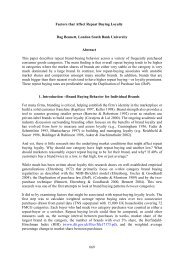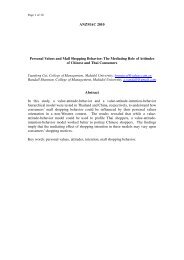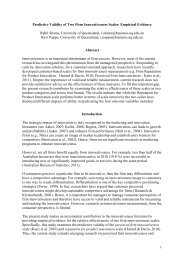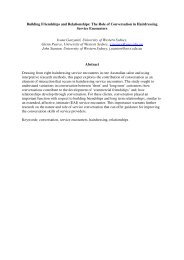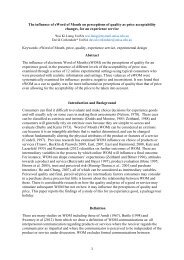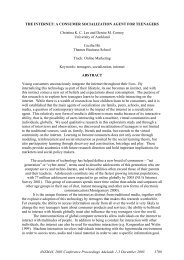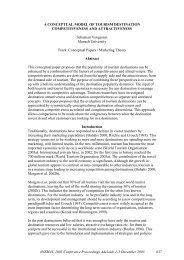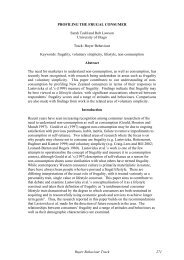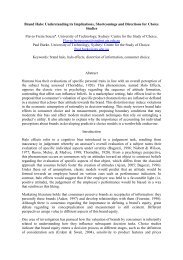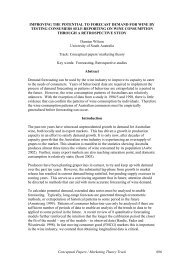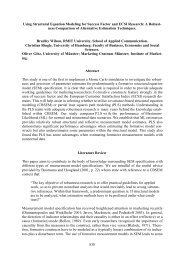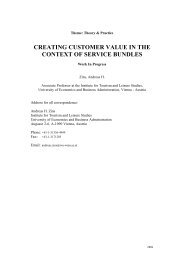amj Australasian Marketing Journal - ANZMAC
amj Australasian Marketing Journal - ANZMAC
amj Australasian Marketing Journal - ANZMAC
Create successful ePaper yourself
Turn your PDF publications into a flip-book with our unique Google optimized e-Paper software.
Executive Summaries<br />
Australian and Taiwanese Advertiser’s Perceptions of<br />
Internet <strong>Marketing</strong><br />
Tzu-wen Hsu, Jamie Murphy, & Sharon Purchase<br />
This research investigated advertiser s perceptions of Internet<br />
marketing. Drawn from two different countries, Australia and<br />
Taiwan, the advertiser perceptions fell into four different clusters:<br />
optimistic tomorrow, cautious adopters, doubting<br />
laggards and technology realists. While Australian advertisers<br />
were represented in all four categories, Taiwanese advertisers<br />
were mainly cautious adopters or technology realists.<br />
When choosing an advertising agency, managers should be<br />
aware of different agency perceptions towards Internet<br />
marketing and choose an agency whose perceptions align<br />
with theirs. With such diverse perceptions of Internet marketing<br />
among advertising agencies, it is important to consider the<br />
type of strategy that matches company perceptions.<br />
Australian organisations entering the Taiwanese market<br />
should be aware that the Taiwanese advertising agencies did<br />
not display such diverse views of Internet marketing. All<br />
Taiwanese agencies indicated a low belief about the future of<br />
Internet marketing. Whether this perception will be sustained<br />
in the longer term is to be determined, but is important now<br />
given the general population s rapid uptake of the Internet.<br />
Taiwanese managers need to be aware of how agency perceptions<br />
of Internet marketing affect their overall advertising<br />
strategy. These perceptions may change as Taiwanese agencies<br />
becomes more experienced with Internet marketing and<br />
eventually becomes as diverse as those in Australia. The low<br />
belief in the future of Internet marketing may change over<br />
time and business managers need to be aware of these<br />
changes as they occur.<br />
Consumer Self-Monitoring Materialism and Involvement<br />
in Fashion Clothing<br />
Aron O’Cass<br />
So how should marketers use knowledge about self-monitoring,<br />
materialism and fashion clothing involvement in order to<br />
formulate and implement marketing mix strategies for the<br />
fashion market? If a product is intended for more general<br />
market, the message must reach both the low and high selfmonitors.<br />
However, for a narrower or niche market, marketing<br />
mix strategies can be developed to cater to the dominant<br />
characteristics explored here. These being the degree of selfmonitoring,<br />
materialism and involvement in the product.<br />
Thus, the self-monitor appears to be both materialistic and<br />
image conscious, implying that appeals needed to be targeted<br />
at the value of the product to fulfill the requirements of the<br />
materialist and the strong desire for image and image adjustment<br />
for the self-monitor.<br />
The findings here imply that the marketer of products, particularly<br />
fashion is more likely to be successful if they target the<br />
86 <strong>Australasian</strong> <strong>Marketing</strong> <strong>Journal</strong> 9 (1), 2001<br />
value of the possession as seen from the materialist view point<br />
and the happiness, success and centrality of possession in<br />
their lives. This would require a marketing mix strategy<br />
encompassing all elements of the mix to effectively target the<br />
desire for display required by self-monitors with strong materialistic<br />
tendencies with image as a primary concern who in<br />
reality have a strong attachment to their clothing. Such<br />
consumers may be more influenced by higher pricing, store<br />
design, product design and advertising that indicates the value<br />
of the product in fulfilling the unique requirement of the selfmonitor<br />
who values possessions and has a need to display the<br />
right image.<br />
More significantly marketers can use the adaptation to<br />
surroundings typifying the self-monitor to manipulate the way<br />
in which they see products as displaying who they are and the<br />
success such display brings. For products and brands reliant<br />
of the nuances of fashion and shifts in it, the right appeal to<br />
right target market catering for self-monitoring, materialism<br />
and involvement could act to sustain market position through<br />
the normal cycle of such fashion dictated markets.<br />
The findings also indicate that consumers may use the image<br />
and signals products and brands already possess instead of<br />
just react or passively receive them. Thus products and brands<br />
with well established images targeted at specific target<br />
markets may require little or no adjustment. These are two<br />
options available to the marketers of fashion products.<br />
An Examination of the Effects of ‘Country-of-Design’<br />
and ‘Country-of-Assembly’ on Quality Perceptions and<br />
Purchase Intentions<br />
Chandrama Acharya & Greg Elliott<br />
This paper has examined the Country of Origin Effect in the<br />
Australian context and, more specifically, examined the<br />
differential impacts of the Country of Assembly (COA) and<br />
Country of Design (COD) constructs along with other product<br />
cues such as brand and price. Among the sample of<br />
Australian graduate students, the most notable conclusion is<br />
that COA appears to be the most important product attribute<br />
of those studied. This applies across all three product categories<br />
studied, viz. cars, jeans and tinned pineapple.<br />
This finding has important implications for both Government<br />
and Australian industry. For Government, this finding carries<br />
mixed implications. On the one hand, it provides endorsement<br />
of recent advertising campaigns which have encouraged<br />
people to buy Australian Made . Clearly these results indicate<br />
that the issue of COA is salient among Australian<br />
consumers as they rate COA above other more familiar product<br />
cues, notably brand and price. On the other hand,<br />
Australian Made products were only preferred in the case of<br />
tinned pineapple; whereas Australian consumers preferred<br />
Japanese-made cars and US-made jeans.<br />
Recent Australian Government advertising directed at distin-



